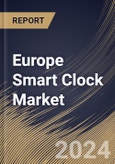The smart clock has become a central hub for controlling and monitoring smart home devices. These enable users to manage their smart home ecosystems and adjust lighting, temperature, and other connected devices with a mere touch or voice command through connectivity features such as Bluetooth and Wi-Fi. Beyond the realms of health and home, these contribute to improved productivity. Integrated calendars, reminders, and task management functionalities make them valuable tools for individuals seeking to organize their daily lives. Receiving notifications, weather updates, and news alerts directly on the clock's display further enhances its utility in the fast-paced contemporary lifestyle.
the growing priority on health and wellness has emerged as a prevailing trend in the market. Consumers are increasingly drawn to devices that provide accurate timekeeping and contribute to their well-being. Consequently, they equipped with advanced health-tracking features have witnessed a surge in demand, reflecting a broader societal shift toward proactive health management. The era of one-size-fits-all devices is fading, and customization has emerged as a substantial trend in the market. Consumers seek devices that align with their individual preferences, and manufacturers are responding by offering various customization options – from interchangeable bands to a diverse array of clock faces and themes.
German households are increasingly adopting connected devices that can be controlled and automated. Smart thermostats, lighting systems, security cameras, smart speakers, and other devices contribute to the overall smart home ecosystem. Government initiatives and regulations promoting energy efficiency and sustainable living contribute to the growth of smart homes. Voice-activated virtual assistants like Amazon's Alexa and Google Assistant are integrated into many smart homes in Germany. German consumers place a high value on privacy and data security. The manufacturers emphasizing robust privacy features and secure data practices can address these concerns and build trust among users. Therefore, the factors mentioned above will propel the market growth in this region.
The Germany market dominated the Europe Smart Clock Market by Country in 2022 and would continue to be a dominant market till 2030; thereby, achieving a market value of $196.2 million by 2030. The UK market is exhibiting a CAGR of 15.8% during (2023 - 2030). Additionally, The France market would experience a CAGR of 17.6% during (2023 - 2030).
Based on Distribution Channel, the market is segmented into Online, Specialty Stores, and Others. Based on countries, the market is segmented into Germany, UK, France, Russia, Spain, Italy, and Rest of Europe.
List of Key Companies Profiled
- Amazon.com, Inc.
- SDI Technologies, Inc.
- Lenovo Group Limited
- Emerson Electric Co.
- Sony Corporation
- Koninklijke Philips N.V.
- Panasonic Holdings Corporation
- Samsung Electronics Co., Ltd. (Samsung Group)
- Google LLC (Alphabet Inc.)
- Bose Corporation
Market Report Segmentation
By Distribution Channel (Volume, Thousand Units, USD Billion, 2019-2030)- Online
- Specialty Stores
- Others
- Germany
- UK
- France
- Russia
- Spain
- Italy
- Rest of Europe
Table of Contents
Companies Mentioned
- Amazon.com, Inc.
- SDI Technologies, Inc.
- Lenovo Group Limited
- Emerson Electric Co.
- Sony Corporation
- Koninklijke Philips N.V.
- Panasonic Holdings Corporation
- Samsung Electronics Co., Ltd. (Samsung Group)
- Google LLC (Alphabet Inc.)
- Bose Corporation








